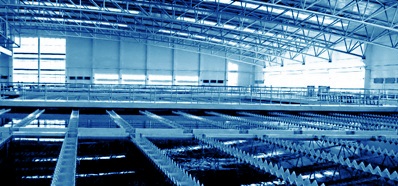Disc aerators
Where Disk Aerators Are Used
The use of disk aerators is one of the most convenient and sought-after methods of oxygenating water. Air, delivered through pipelines by blowers, passes through a special perforated material, a membrane, thereby creating fine bubbles on the water surface and ensuring its oxygen saturation. The main purpose of a disk aerator is to supply oxygen to structures for wastewater treatment.
Disk aerators are used in various areas:
- Wastewater treatment plants
- Aeration tanks: The aeration system is used for biological wastewater treatment, oxidizing pollutants with oxygen from the air and promoting biomass growth. Fine bubble aeration ensures even air distribution throughout the water column, ensuring a high degree of oxygen dissolution.
- Aerobic stabilizers equipped with aeration systems to improve sediment properties and combat pollution in hard-to-reach areas.
- Flotation units, where disk aerators remove particles of pollution that cannot be removed by sedimentation. Bubbles lift particles to the surface, forming a stable foam that is then removed.
- Water bodies and fish farms: Aeration of water is necessary for successful fish breeding and storage, especially in summer, to compensate for oxygen deficiency during fish transportation.
Advantages of Using Disk Aerators
Disk aerators have several undeniable advantages in use:
- The material of disk aerators is sturdy and durable: it is chemically and thermally resistant, preventing surface deposition and capable of operating in aggressive environments. The material is resistant to ultraviolet radiation, high temperatures, and mechanical damage.
- Versatility of use: Suitable for various types of wastewater – municipal, industrial, and domestic.
- Longevity: With proper operation, a disk aerator can serve for 7-10 years, maintaining its functional characteristics.
- Autonomy: A disk aerator automatically closes when air supply is interrupted, preventing the ingress of foreign mixtures. Pressure resistance rings prevent water from entering the aerator.
- Ease of use: Easy installation, ease of operation, and replacement of worn-out membranes pose no difficulties.
- Sleek design: A combination of durable material with a minimalist design.
- Endurance: The operating system of a disk aerator ensures uniform distribution of bubbles even under maximum loads.
Disk aerators are a reliable and efficient means of aerating wastewater, effectively performing the functions assigned to them. Their unique characteristics and advantages make them in demand in various fields of application.
The use of disk aerators includes not only the sphere of wastewater treatment but also providing conditions for the successful functioning of biological processes in water systems. Their use in aeration tanks contributes to efficient biological wastewater treatment, while in aerobic stabilizers, it helps improve sediment quality and prevents pollution in hard-to-reach areas.



